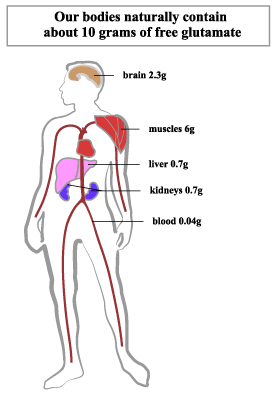Glutamate: One of the Building Blocks of Proteins
 Glutamate (from the amino acid glutamine) is found naturally in protein-containing foods such as meat, vegetables, poultry and milk. The human body also produces glutamate as part of normal metabolism. The muscles, brain and other organs store about four pounds of glutamate, and mother’s milk is rich in glutamate.
Glutamate (from the amino acid glutamine) is found naturally in protein-containing foods such as meat, vegetables, poultry and milk. The human body also produces glutamate as part of normal metabolism. The muscles, brain and other organs store about four pounds of glutamate, and mother’s milk is rich in glutamate.
Glutamate signals the presence of protein, our dietary source of the amino acids we need for healthy growth and development and for normal metabolism throughout life.
Umami taste may be recognized even before birth as human amniotic fluid contains significant levels of glutamate. Human breast milk, the sole source of nutrition for most children in their early months, is very rich in free glutamate. Indeed, a newborn, breast-fed infant consumes free glutamate at levels far higher, for its weight, than we do from our diet later in life.
Free Glutamate
Glutamate is found in two forms: “bound” glutamate (linked to other amino acids in protein) and “free” glutamate.
 Foods which are high in free glutamate, like ripe tomatoes and cheeses, are considered tasty. Only free glutamate can be detected by the umami taste receptors. The umami receptors on the tongue are uniquely receptive to glutamate, which explains why free glutamate is effective in enhancing the tastiness of food.
Foods which are high in free glutamate, like ripe tomatoes and cheeses, are considered tasty. Only free glutamate can be detected by the umami taste receptors. The umami receptors on the tongue are uniquely receptive to glutamate, which explains why free glutamate is effective in enhancing the tastiness of food.
The glutamate from MSG seasoning and the glutamate occurring naturally in food is exactly the same, and the body treats glutamate in the same way no matter what its source.
We consume between 10g and 20g of glutamate per day from our diet, of which glutamate from seasoning or condiments is less than 10%. The U.S. Food & Drug Administration (FDA) notes that a typical serving of a food with added monosodium glutamate (MSG) contains less than 0.5 grams of MSG.
Glutamic acid is one of the 20 amino acids which are the building blocks of proteins in the body. Because it is made by the body as part of normal metabolism, it is a non-essential amino acid.
Monosodium Glutamate (MSG) in Foods
 Increasing the level of free glutamate in a dish during cooking or processing is a simple and effective way to increase umami taste and balance.
Increasing the level of free glutamate in a dish during cooking or processing is a simple and effective way to increase umami taste and balance.
Umami Taste
In recipe development, glutamate is added at levels similar to those in traditional recipes. The taste can also be enhanced by using glutamate-rich condiments to season the dish before serving or at the table. In cooking, seasoning foods with MSG is the simplest, purest way to add the umami taste to food.
Glutamic Acid:
Monosodium Glutamate:


In chemistry, mono- means one, thus monosodium refers to one molecule of sodium. MSG has been used for more than 100 years to enhance and balance the taste of many dishes. It adds umami taste, which is best described as savory, broth-like or meaty taste.


